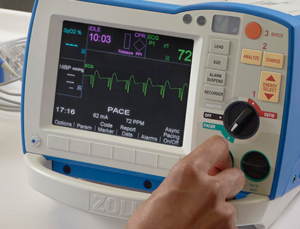Monitor/Defibrillator (Zoll)
Posted on: April 8, 2025, by : Haroon Shaukat MD
Key Operational Features of ZOLL Defibrillators:
- Defibrillation: Delivers unsynchronized electrical shocks to terminate life-threatening arrhythmias like ventricular fibrillation or pulseless ventricular tachycardia.
- Synchronized Cardioversion: Provides synchronized shocks timed with the R-wave of the ECG to correct arrhythmias such as atrial fibrillation or supraventricular tachycardia.
- External (Transcutaneous) Pacing: Offers non-invasive pacing for patients with symptomatic bradycardia or as a bridge to permanent pacing.
Steps for Defibrillation:
- Power On the Defibrillator: Turn the selector switch to the “Defib” mode.
- Attach Electrodes/Pads:
- Place adhesive pads on the patient’s bare chest:
- One pad below the right clavicle.
- The other on the left lateral chest, mid-axillary line.
- Charge the Defibrillator:
- Select the appropriate energy level (e.g., 200 joules for adults).
- Press the “Charge” button; wait until the device indicates it’s ready.
- Deliver the Shock:
- Ensure everyone is clear of the patient.
- Press the “Shock” button to administer the shock.
- Resume CPR: Immediately continue chest compressions for two minutes before re-assessing the rhythm.

Steps for Synchronized Cardioversion:
- Power On the Defibrillator: Set the selector switch to “Defib” mode.
- Attach Electrodes/Pads: Place pads as described above.
- Activate Sync Mode:
- Press the “Sync” button; verify that markers appear above each R-wave on the ECG display.
- Select Energy Level:
- Choose the appropriate joules based on the arrhythmia and patient size.
- Charge and Deliver Shock:
- Press “Charge” and wait for the ready prompt.
- Ensure clear surroundings.
- Press “Shock” to deliver the synchronized shock.
- Reassess Patient: Check rhythm and patient status; repeat if necessary.

Steps for External Pacing:
- Power On the Defibrillator: Turn the selector switch to “Pacer” mode.
- Attach Electrodes/Pads: Place pads on the patient’s chest as previously described.
- Set Pacing Parameters:
- Rate: Adjust to desired beats per minute (typically starting at 60-80 bpm).
- Current: Start at a low milliampere (mA) setting and gradually increase until electrical capture is achieved (evidenced by widened QRS complexes and corresponding pulses).
- Assess Mechanical Capture:
- Check for a palpable pulse corresponding with paced rhythm.
- Monitor patient’s blood pressure and overall condition.
- Monitor and Adjust:
- Continuously observe ECG and patient response.
- Adjust pacing rate and current as needed for optimal patient stability.

Using the ZOLL Defibrillator in AED Mode
✅ Purpose:
When set to AED mode, the ZOLL defibrillator analyzes the patient’s heart rhythm and prompts the user to deliver a shock only if indicated—ideal for BLS providers or during pediatric codes requiring quick use.
✅ Steps for Using ZOLL as an AED:
1. Power On the Device
- Turn the selector knob to “AED” mode (if model has dedicated AED setting) or press the power button and activate AED mode if prompted.
2. Attach the Electrode Pads
- Expose the chest and ensure it is dry.
- Apply pads as shown on the diagrams (on the pads themselves):
- Anterior-Posterior (preferred for small children):
- Anterior-Lateral (for larger children/adolescents):
- Use pediatric pads/attenuator if available for children <8 years or <25 kg.
3. Follow the AED Voice and Screen Prompts
- ZOLL devices provide clear audio and visual instructions.
- The machine will analyze the rhythm automatically—ensure no one is touching the patient.
4. If Shock is Advised:
- The machine will charge automatically.
- LOUDLY state “CLEAR” and make sure no one is touching the patient.
- Press the “Shock” button when prompted.
5. Resume Chest Compressions Immediately
- After shock delivery, start CPR right away (2 minutes of chest compressions).
- The AED will prompt you when to stop for the next rhythm analysis.
✅ Special Pediatric Considerations:
- Use pediatric pads/energy attenuator if available for children under 8 years.
- If only adult pads are available, use them—it is better to shock than delay.
- Pads should never touch each other; place anterior-posterior if chest size is too small.
✅ Safety Reminders:
- Do not use in standing water or if chest is wet—dry thoroughly first.
- Remove medication patches before pad placement.
- Ensure proper pad placement for effective shock delivery.
✅ Optional Video Resource:
